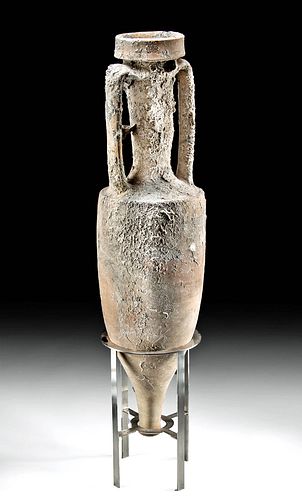Monumental Roman Terracotta Sea Amphora
Lot 80
About Seller
Artemis Fine Arts
686 S Taylor Ave, Ste 106
Louisville, CO 80027
United States
Selling antiquities, ancient and ethnographic art online since 1993, Artemis Gallery specializes in Classical Antiquities (Egyptian, Greek, Roman, Near Eastern), Asian, Pre-Columbian, African / Tribal / Oceanographic art. Our extensive inventory includes pottery, stone, metal, wood, glass and textil...Read more
Categories
Estimate:
$5,000 - $7,000
Absentee vs Live bid
Two ways to bid:
- Leave a max absentee bid and the platform will bid on your behalf up to your maximum bid during the live auction.
- Bid live during the auction and your bids will be submitted real-time to the auctioneer.
Bid Increments
| Price | Bid Increment |
|---|---|
| $0 | $25 |
| $300 | $50 |
| $1,000 | $100 |
| $2,000 | $250 |
| $5,000 | $500 |
| $10,000 | $1,000 |
| $20,000 | $2,500 |
| $50,000 | $5,000 |
| $100,000 | $10,000 |
| $200,000 | $20,000 |
About Auction
By Artemis Fine Arts
Jun 10, 2021
Set Reminder
2021-06-10 10:00:00
2021-06-10 10:00:00
America/New_York
Bidsquare
Bidsquare : Exceptional Antiquities | Asian | Ethnographic
https://www.bidsquare.com/auctions/artemis-gallery/exceptional-antiquities-asian-ethnographic-7012
Museum-worthy examples of Egyptian, Greek, Roman, Viking, Near Eastern, Far East / Asian, Pre-Columbian, African / Tribal, Oceanic, Native American, Spanish Colonial, Russian, Fossils, Ancient Jewelry, Fine Art, so much more! Artemis Fine Arts info@artemisgallery.com
Museum-worthy examples of Egyptian, Greek, Roman, Viking, Near Eastern, Far East / Asian, Pre-Columbian, African / Tribal, Oceanic, Native American, Spanish Colonial, Russian, Fossils, Ancient Jewelry, Fine Art, so much more! Artemis Fine Arts info@artemisgallery.com
- Lot Description
Roman, late Republic to early Imperial period, ca. 1st century BCE to 1st century CE. A quintessential terracotta transport amphora of magnificent scale enveloped in extensive oceanic encrustations from centuries spent in the depths of the sea. The gorgeous vessel presents with a folded rim atop an extended conical neck, a gently sloped shoulder with an angular edge, and a cylindrical body tapering to a pointed base. Twin ribbon-form handles extend from the shoulders to just below the thick rim. The wide, beige-hued body would have held gallons worth of precious oils used to sustain legions of Roman troops which traveled and settled in most of Western Europe and Britain. Utilitarian transport vessels like this were not typically decorated with painted designs or applied details, though some exhibit markings that denote the materials contained within. Size: 12" in diameter x 47" H (30.5 cm x 119.4 cm); 52" H (132.1 cm) on included custom stand.
Lacking its cork and pitch stopper, the original contents of this amphora are unknown; based on the size and shape, it was most likely used to transport wine (smaller ones were for stewed fruit, salted fish, or olive oil). Amphorae formed the basis of the Roman economy as storage vessels for transporting goods throughout the Empire, with examples found from North Africa to Britain. The pointed base on this piece is standard and was intended for storage in Roman warehouses in soft ground and for transport on ships by placing it through a specially-designed rack and roping it through the handles to others. This vessel was likely made near Cosa in Etruria. Roman cargo ships of wine amphorae, like this one, frequently traveled to Gaul as Celtic chieftains had developed a taste for wine and tableware supplied by Roman merchants.
A nearly identical amphora of slightly smaller scale can be found in the Metropolitan Museum of Art under accession number 53.70.
This piece has been searched against the Art Loss Register database and has been cleared. The Art Loss Register maintains the world’s largest database of stolen art, collectibles, and antiques.
Provenance: East Coast, USA collection, acquired prior to 2010; ex-gallery collection, New York, New York, USA
All items legal to buy/sell under U.S. Statute covering cultural patrimony Code 2600, CHAPTER 14, and are guaranteed to be as described or your money back.
A Certificate of Authenticity will accompany all winning bids.
We ship worldwide and handle all shipping in-house for your convenience.
#157781Stable hairline pressure fissure beneath top of handle on one side. Adhesive for stabilization along another stable pressure fissure that wraps 3/4 around body horizontally. Some nicks, scratches, and abrasions, commensurate with age. Otherwise, intact and excellent with amazing encrustations of barnacles and shells.Condition
- Shipping Info
-
All shipping is handled in-house for your convenience. Your invoice from Artemis Gallery will include shipping calculation instructions. If in doubt, please inquire BEFORE bidding for estimated shipping costs for individual items.
-
- Buyer's Premium



 EUR
EUR CAD
CAD AUD
AUD GBP
GBP MXN
MXN HKD
HKD CNY
CNY MYR
MYR SEK
SEK SGD
SGD CHF
CHF THB
THB














